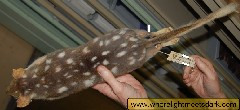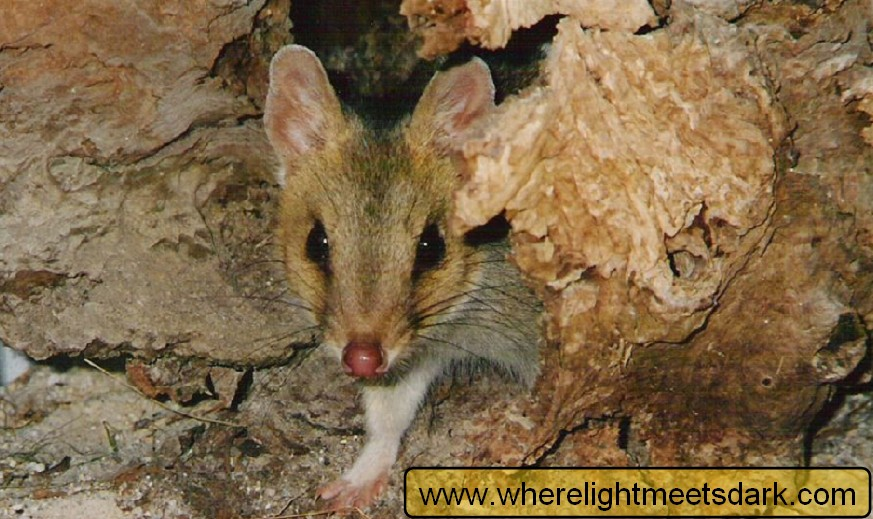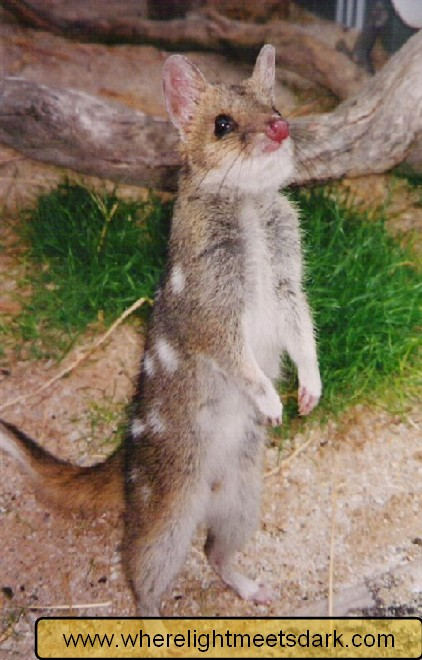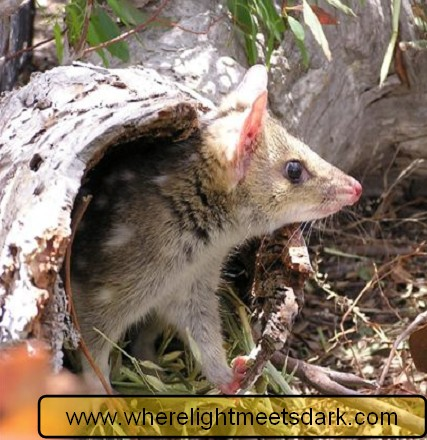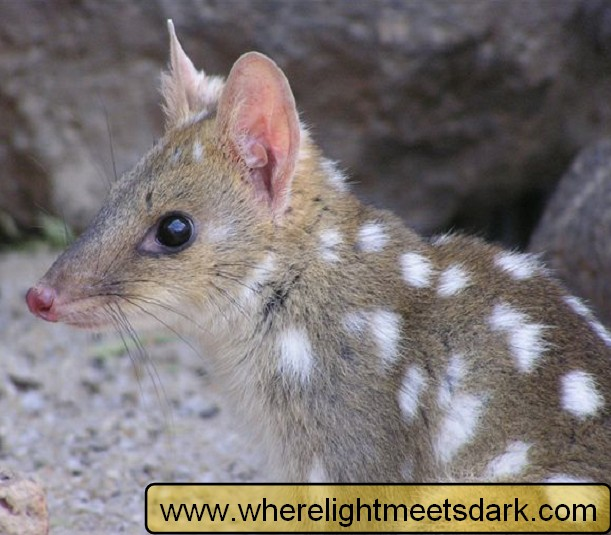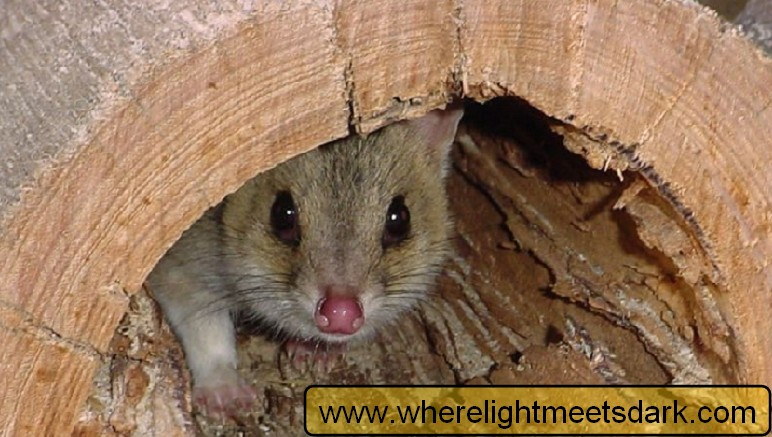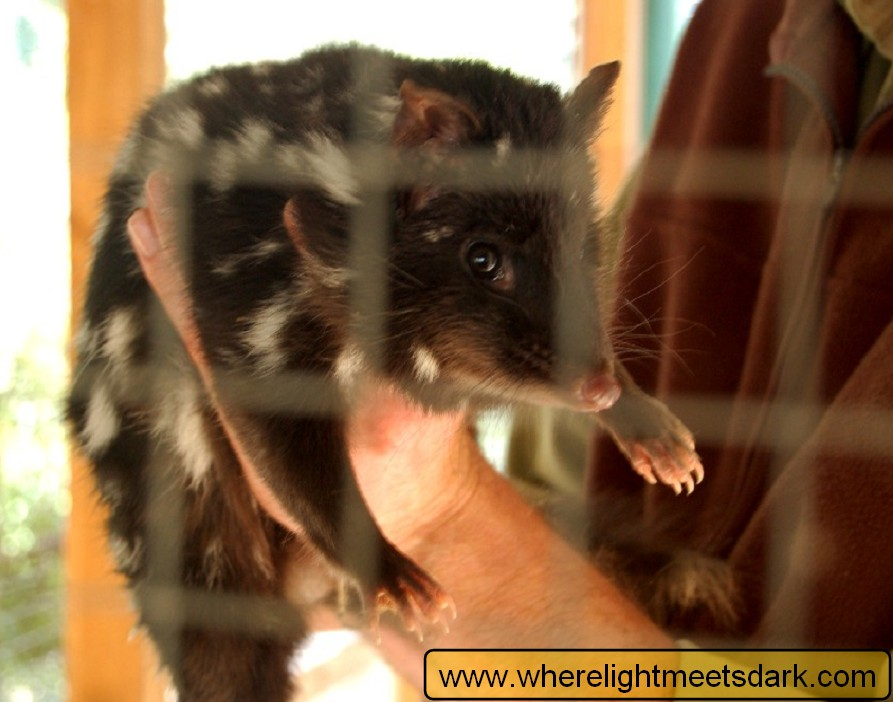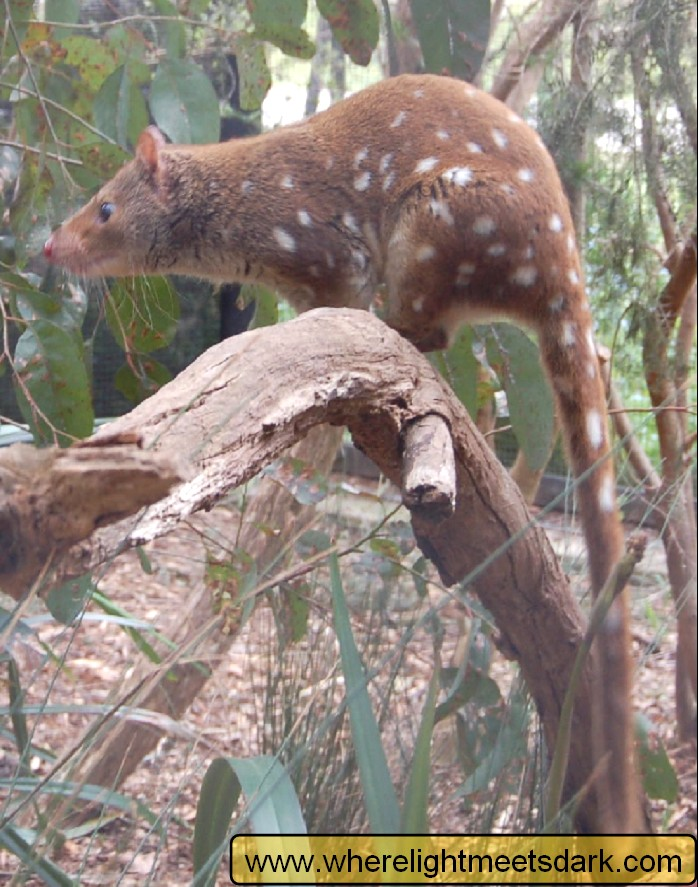Mainland Eastern quoll sightings
The last mainland Eastern quoll
In June 2008 I had the privilege of examining the last mainland Eastern quoll. Follow the link to see the photo (and specific terms regarding the usage of this photo - it may not be reproduced).
Mainland Eastern quoll sightings
The last confirmed Eastern quoll on mainland Australia (they still persist on the island state of Tasmania but are now under threat by the recent introduction of foxes there) was discovered as roadkill in the Sydney suburb of Vaucluse in January 1963.
Although Eastern quolls were numerous at the time of European colonisation, their numbers dropped rapidly as they became avid poultry theives and were hence hunted.
Since this time it has been argued that Eastern quolls are in fact beneficial to farmers because they predate on insect species which ravage crops.
At any rate, Eastern quoll numbers seemed to decline dramatically almost uniformly across their range in the late 1950s and early 1960s and some researchers conclude that a disease may have contributed to the species demise, much the same way that devil facial tumour disease (DFTD) is currently affecting Tasmanian devils in Tasmania.
The Vaucluse population persisted, it is believed, because of its geographic isolation from disease-affected populations.
East Kurrajong, 2006
In 2006 a news report was released indicating that a resident of East Kurrajong observed two Eastern quolls on her way to work. Eastern quolls are very similar in appearance to spotted-tailed quolls (see last photo on this page) which are known to persist on the mainland. However in this case the witness researched the differences and then made the effort to contact the National Parks and Wildlife service to insist the animals she saw were Eastern quolls, not spotted-tailed quolls.
This sighting is interesting because it occurred during the time of year when young quolls disperse from their parents. The witness saw two animals - one large and one small - fitting the description of adult and young.
Again, the difficulty with Eastern quoll sightings is that spotted-tailed quolls are so similar. However, spotted-tailed quolls grow much larger and heavier than Eastern quolls, so the fact there were two differently sized animals - with the largest corresponding to that of an adult Eastern quoll (and not spotted-tailed quoll) also strengthens the case for this being a genuine EQ sighting. (A juvenile spotted-tailed quoll at the age corresponding to that time of year would have been about the size of the larger animal; likewise a male-female pair of spotted-tailed quolls would have seen the smaller female still at the size of the larger animal observed.)
Near East Kurrajong, 2000 or 2001
My enquiries into the East Kurrajong sighting revealed another sighting made approximately 5 years prior. In this instance a quoll had been trapped in a chook pen. The property-owner contacted authorities who advised it was probably a spotted-tailed quoll. They released the animal and quoll-proofed their pen. Having read the East Kurrajong sighting in the newspaper 5 years later they again contacted authorities to clarify that the animal they had trapped in their pen was in fact an Eastern quoll, not a spotted-tailed quoll.
Due to agreement to maintain confidentiality I am unable to disclose the name of the witness, source of information or exact location.
North of Sydney, 2006
A second sighting occurred in the same month of the East Kurrajong sighting some tens of kilometres distant. In this case the witness was a wildlife worker and his friend. They were spotlighting at night in search of reptiles when they found an Eastern quoll beside the road. They turned their vehicle around and shone their headlights on the animal for a period of 5 to 10 minutes while they watched it move around only a few metres away. The wildlife worker immediately recognised it as an Eastern quoll and said they were familiar with seeing Eastern quolls decades ago. (This is an interesting point to note because they felt they had seen them in the wild in the 1970s). Being in the habit of observing wildlife he made mental notes about specific features of the animal and then researched it in a textbook some days later. Comparing spotted-tailed quolls with Eastern quolls on facing pages of the book, he had no doubt it was an Eastern qoull. He showed the same pages to his friend and asked him which one they saw. The friend agreed it was an Eastern quoll.
Blue Mountains, date unknown
Once again, whilst pursuing sightings data I conversed with a university researcher who had a colleague who is a veterinary surgeon. The vet observed an Eastern quoll run across their backyard in the Blue Mountains. Although I don't have a specific date I got the impression this was relatively recently; perhaps some time from 2000 onwards. I have no way of knowing whether the vet understood the difference between spotted-tailed quolls and Eastern quolls except that the researcher understood this clearly and related the sighting to me as an Eastern quoll sighting.
Mudgee, circa 1985
In April 2008 I met with an associate professor who has been acquiring mystery animal sightings since 1950. He recalled seeing a news article in about 1985 of an Eastern quoll being captured in the Mudgee area. Whilst he is currently tracking down the article for me, much of his work was destroyed by flooding of his house in 2007.
(The Eastern quoll shown here is the less common black form)
New England area, circa 1990s
Another amatuer researcher reported to me that he recalled an Eastern quoll being trapped in the New England area in the 1990s as part of a wildlife monitoring program. It was his impression that the NSW Parks department was aware of this capture. I have not obtained any further information on this claim.
Northern NSW, May 1996
In a NSW parliamentary hearing, the Honorable I. Cohen asked the Honorable J. W. Shaw about an Eastern quoll sighting reported in mainstream media on 11 May 1996. The news article, in the Daily Telegraph was written by Simon Benson and described biologists employed by State Forests sighting an Eastern quoll in a forest in northern NSW.
The Honorable J. W. Shaw's reply was made in November 1996 and cites the Minister for Land and Water Conservation saying that biologists employed by State Forests have not recorded any sighting of this species in this area. Further, the National Parks and Wildlife Service has not advised State Forests of this species in this area.
Carrai Forest, NSW, circa before 1991
In answering the Honorable I. Cohen's question in NSW parliament (see "Northern NSW, May 1996" above), the Honorable J. W. Shaw cites the Minister for Land and Water Conservation as advising that State Forests is aware of a CSIRO sighting of this species from a vehicle in Carrai State Forest more than 5 years prior to May 1996. Extensive surveys were undertaken by a number of organisations including CSIRO without any further evidence of the species.
Nowra, NSW 1986
One reader of this website reported seeing an Eastern quoll near a picnic area in Minnamurra Falls National Park near Nowra in 1986 in full view of hundreds of visitors plus park rangers. After commenting on this page that "I have no way of knowing whether this witness might have confused a spotted-tailed quoll which have been documented numerous times to become bold around picnic grounds.", the witness contacted me again to clarify: "You are right, at the time I didn't know the difference between the Eastern and Spotted Tail Quoll so I couldn't guarantee that it wasn't the latter although the size (half the size of a cat) and the lighter brown colour makes me still think it was an Eastern Quoll."
Casino, NSW 1980
I have been informed of an account that comes from Casino in about 1980. Allegedly an Eastern quoll was found to have killed 32 fowl on a property over the course of 2 nights. Traps were laid and the animal was caught. The farm owners were sympathetic and released the quoll at a more remote location, but not before taking photographs.
At time of writing I have not yet seen the alleged photographs, but the witness describes the quoll as their favourite animal - perhaps indicating a good chance at a correct identification?
Little River, Victoria, 2005
I have reports of two deceased Eastern quolls being recovered from Victoria - one a roadkill, the other a drowning. In both cases the body is no longer available for examination.
- Read the full story in the Victorian Eastern quoll specimens article.
Little River, Victoria, 2008
Two more quolls were discovered as roadkill at Little River in 2008. These were collected and forwarded to Museum Victoria. As with the 2005 specimens they likely originated with the nearby free-range feral-proof sanctuary.
- Read the full story in the Victorian Eastern quoll specimens article.
Summary
(This is a spotted-tailed quoll, shown here for comparison)
Despite the possibility of a misidentification of spotted-tailed quolls, I believe there is merit in investigating these sightings further. Certainly in a number of cases the witness either explicitly compared spotted-tailed quolls with Eastern quolls, or is of an employment status to suggest they understand this difference and would not intentionally confuse the two.
The two most recent sightings are reasonably near to Sydney, thus making it possible for me to deploy trail cameras in search of Eastern quolls. In March 2008 I purchased my first commercial trail camera unit and began testing with cats in the backyard. The result is this review of the Moultrie GameSpy I-40 infra-red trail camera. It was first deployed in search of Eastern quolls, in the vicinity of the more recent sightings, in April 2008.
Updates on the results of this camera's deployment will be periodically posted on this page. The camera's name is Charlie :)
Camera Deployments
Copyright Notice
Note:
- All images of fawn Eastern quolls in this article are copyright Andrea Little / Mt Rothwell Sanctuaries. Used with permission.
- The images of the black Eastern quoll and spotted-tailed quoll are copyright Where Light Meets Dark
The black Eastern quoll is part of Secret Creek Sanctuary's breeding program in Lithgow, NSW. The spotted-tailed quoll is a female from Healesville Sanctuary, Victoria - see more of this beautiful animal here. The fawn quolls were all part of Mt Rothwell Sanctuary's breeding program in Victoria.
